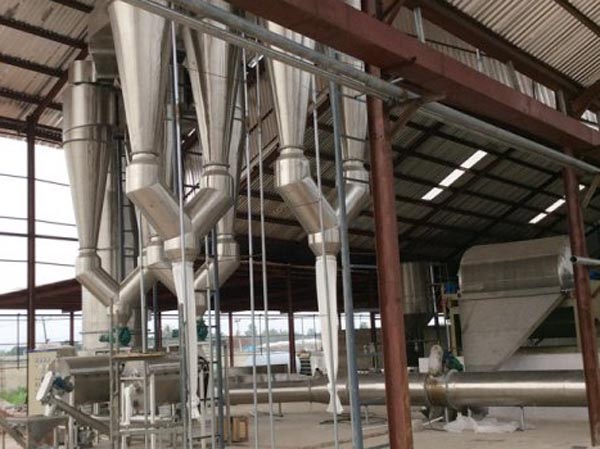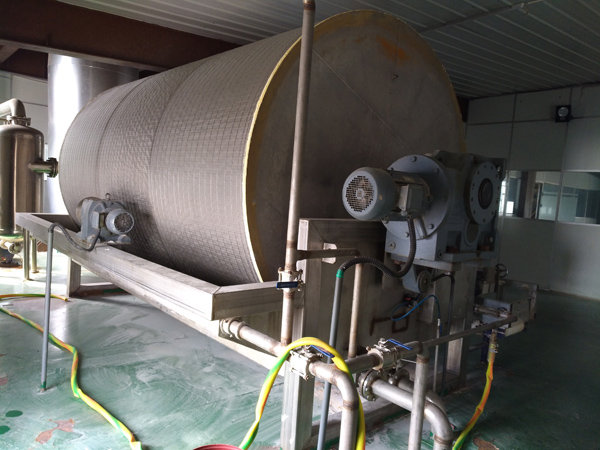biocatalytic proccess of production of high fructose syrup slide share
biocatalytic proccess of production of high fructose syrup slide share
Biocatalysts can catalyze proteins, RNA or their complexes in specific chemical reactions. They can speed up the reaction by reducing the activation energy of the reaction, but do not change the equilibrium point of the reaction. The chemical nature of most enzymes is protein. It has the characteristics of high catalytic efficiency, strong specificity and mild reaction conditions.
The essence of enzymatic catalysis is to reduce the activation energy efficiency of chemical reaction: the catalytic efficiency of enzymes is higher than that of inorganic catalysts, which makes the reaction rate faster;
Specificity: An enzyme can catalyze only one or a class of substrates, such as protease, which can only catalyze the hydrolysis of proteins into polypeptides.
Diversity: There are many kinds of enzymes, about 4000 kinds.
Mildness: The chemical reactions catalyzed by enzymes are generally carried out under mild conditions.
Activity adjustability: including inhibitor and activator regulation, feedback inhibition regulation, covalent modification regulation and structure regulation, etc.
Relevance: Some enzymes are related to cofactors.
Variability; most enzymes are proteins (a few are RNA), which can be destroyed by high temperature, strong acid, strong alkali, etc.
Generally speaking, the optimum temperature of enzymes in animals is between 35 and 40 degrees Celsius, the optimum temperature of enzymes in plants is between 40 and 50 degrees Celsius, and the optimum temperature of enzymes in bacteria and fungi is quite different, with the optimum temperature of enzymes as high as 70 degrees Celsius. Most of the optimum PH of enzymes in animals is between 6.5 and 8.0, but there are some exceptions, such as the optimum PH of pepsin is 1.5, and the optimum PH of enzymes in plants is between 4.5 and 6.5.
These properties of enzymes enable the intricate process of intracellular material metabolism to proceed in an orderly manner, so that material metabolism and normal physiological functions can be adapted to each other. If a genetic defect causes an enzyme defect, or other causes the enzyme activity to weaken, it can lead to abnormal reactions catalyzed by the enzyme, disorder of material metabolism and even disease. Therefore, the relationship between enzymes and medicine is very important. Close. Same point:
Change the rate of chemical reaction, it is almost not consumed; only catalyze the existing chemical reaction; accelerate the rate of chemical reaction, shorten the time to reach equilibrium, but do not change the equilibrium point; reduce the activation energy, make the rate of chemical reaction faster; poisoning will occur.
Differences: Inorganic catalysts generally have a longer life than enzymes and are not easily poisoned. The stability of enzymes is not as good as that of inorganic catalysts, and the cost is much higher. But enzymes have terrible efficiencies. Usually the catalytic rate of enzymes is more than one million times that of inorganic catalysts. So enzymes are generally used in high-tech fields such as medicine and pharmaceuticals, depending on the quality of products. According to the different reactions catalyzed by enzymes, enzymes are divided into six categories:
Oxidoreductases promote the oxidation or reduction of substrates.
Transfases promote the exchange or transfer of certain chemical groups between molecules of different substances.
Hydrolases promote hydrolysis.
Lyases catalyze the addition or de-group reaction from the double bond of the substrate molecule, that is, to promote the splitting of a compound into two compounds, or to synthesize a compound from two compounds.
Isomerases promote the transformation of isomers, i.e. catalyze the rearrangement reaction within the substrate molecule.
Synthetic enzymes (ligases) promote the binding of two molecules, while ATP molecules (or other nucleosides of triphosphate) break the high-energy phosphate bond, that is, catalyze the intermolecular association reaction.
According to the unified classification principle of enzymes published by the International Biochemical Association, on the basis of the above six categories, each of the enzymes is divided into several subgroups according to the characteristics of the groups or bonds in the substrate. In order to more accurately describe the properties of the substrate or reactants, each subgroup is further divided into several groups (subgroups); each group contains several enzymes directly. Biocatalyst technology is an integral part of chemical biotechnology. As a means or tool of chemical synthesis, it is becoming more and more important. Consumers'demand for new products requires industry to increase revenue and reduce costs. Pressure from government and administrative departments to strengthen management and the emergence of new technologies and scientific inventions have promoted the application of biocatalysts. (Analysis of the real purpose of mainstream funds, find the best profit opportunities! )
Despite the production of high fructose corn syrup, sweeteners and anticancer drugs, biocatalysts have not yet shown their potential. It is urgent for industry, non-profit organizations, government departments, academic units and national laboratories to work together. Some of the objectives proposed in the plan are to develop its potential, analyze technical barriers and problems to be solved. At the same time, in order to implement the plan, the report also puts forward suggestions for its implementation.
Objectives: Biocatalyst planning objectives include reducing material, water and energy consumption and pollution sources to 30% in the traditional chemical industry over the next 20 years. For biocatalysts, the following specific objectives are: to develop better, faster and cheaper biocatalysts than existing chemical catalysts; to develop a series of biocatalysts so that they can play a catalytic role in a wider range of reactions and have wider versatility as far as possible; to improve the stability of temperature, reactivity and solvent compatibility; and to develop molecular modeling. Quickly design new enzymes from scratch; create better means or tools for the development of biocatalysts; educate the public on the social benefits of using and creating biocatalysts.
How much does a cassava starch Read More
How much does a cassava starch machine cost - The price of a cassava starch production line machine...
The cassava starch production lRead More
The following are the main steps and equipment components of a typical cassava starch production line:Cleaning and peeling: Clean the harvest...

scale cassava flour processing
This is the second time that a Nigerian customer has purchased cassava processing equipment from SDA Holdings-Kaifeng SDA Agricultural Equipment Engineering Co., Ltd. Nigerian customers have previously purchased a cassava peeling machine. SD
Read More
Cassava starch production plant
Cassava starch production plant installed in Nigeria,One day processing 100 tons of tapioca starch processing machinery and equipment,We provide customers with tapioca starch processing machine turnkey engineering
Read More



 machine366@outlook.com
machine366@outlook.com




